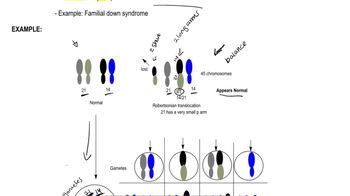Table of contents
- 1. Introduction to Genetics51m
- 2. Mendel's Laws of Inheritance3h 37m
- 3. Extensions to Mendelian Inheritance2h 41m
- 4. Genetic Mapping and Linkage2h 28m
- 5. Genetics of Bacteria and Viruses1h 21m
- 6. Chromosomal Variation1h 48m
- 7. DNA and Chromosome Structure56m
- 8. DNA Replication1h 10m
- 9. Mitosis and Meiosis1h 34m
- 10. Transcription1h 0m
- 11. Translation58m
- 12. Gene Regulation in Prokaryotes1h 19m
- 13. Gene Regulation in Eukaryotes44m
- 14. Genetic Control of Development44m
- 15. Genomes and Genomics1h 50m
- 16. Transposable Elements47m
- 17. Mutation, Repair, and Recombination1h 6m
- 18. Molecular Genetic Tools19m
- 19. Cancer Genetics29m
- 20. Quantitative Genetics1h 26m
- 21. Population Genetics50m
- 22. Evolutionary Genetics29m
6. Chromosomal Variation
Chromosomal Rearrangements: Deletions
Problem 32d
Textbook Question
A healthy couple with a history of three previous spontaneous abortions has just had a child with cri-du-chat syndrome, a disorder caused by a terminal deletion of chromosome 5. Their physician orders karyotype analysis of both parents and of the child. The karyotype results for chromosomes 5 and 12 are shown here. Diagram the pairing of the abnormal chromosomes.
 Verified step by step guidance
Verified step by step guidance1
Step 1: Understand the genetic basis of cri-du-chat syndrome. This disorder is caused by a terminal deletion on the short arm of chromosome 5 (5p). The deletion results in the loss of genetic material, leading to the characteristic symptoms of the syndrome.
Step 2: Review the karyotype analysis results for the parents and the child. Focus on identifying any structural abnormalities in chromosomes 5 and 12, such as deletions, translocations, or other rearrangements.
Step 3: Diagram the pairing of the abnormal chromosomes during meiosis. To do this, illustrate how the deleted chromosome 5 from the child aligns with the normal chromosome 5 from the parent. Use a visual representation to show the missing segment on chromosome 5p.
Step 4: Consider the possibility of a balanced translocation in one of the parents. If one parent has a balanced translocation involving chromosomes 5 and 12, this could explain the inheritance pattern and the occurrence of cri-du-chat syndrome in the child. Diagram how the translocated chromosome pairs with its homologous chromosome during meiosis.
Step 5: Label the diagram clearly to indicate the normal and abnormal chromosomes, the deleted region on chromosome 5, and any translocations involving chromosome 12. This will help visualize the genetic mechanism leading to the disorder.
 Verified video answer for a similar problem:
Verified video answer for a similar problem:This video solution was recommended by our tutors as helpful for the problem above
Video duration:
2mPlay a video:
Was this helpful?
Key Concepts
Here are the essential concepts you must grasp in order to answer the question correctly.
Karyotype Analysis
Karyotype analysis is a laboratory technique that involves the examination of an individual's chromosomes to identify genetic abnormalities. It provides a visual representation of the number and structure of chromosomes, allowing for the detection of deletions, duplications, or other chromosomal rearrangements. In this case, it is crucial for understanding the chromosomal basis of cri-du-chat syndrome and assessing the genetic status of the parents.
Recommended video:
Guided course

Chi Square Analysis
Cri-du-chat Syndrome
Cri-du-chat syndrome is a genetic disorder caused by a deletion of a portion of chromosome 5, specifically at the 5p15.2 region. This condition is characterized by distinctive features such as a high-pitched cry resembling that of a cat, developmental delays, and various physical anomalies. Understanding this syndrome is essential for interpreting the karyotype results and the implications for the family.
Recommended video:
Guided course

Robertsonian Translocations
Chromosomal Deletion
A chromosomal deletion occurs when a segment of a chromosome is missing or deleted, which can lead to genetic disorders due to the loss of essential genes. In cri-du-chat syndrome, the deletion affects critical genes on chromosome 5, resulting in the symptoms associated with the disorder. Recognizing the nature of chromosomal deletions is vital for understanding the genetic risks and potential outcomes for the couple's future pregnancies.
Recommended video:
Guided course

Deletions
Related Videos
Related Practice
Textbook Question
The mutations called bobbed in Drosophila result from variable reductions (deletions) in the number of amplified genes coding for rRNA. Researchers trying to maintain bobbed stocks have often documented their tendency to revert to wild type in successive generations. Propose a mechanism based on meiotic recombination which could account for this reversion phenomenon. Why would wild-type flies become more prevalent in Drosophila cultures?
377
views


